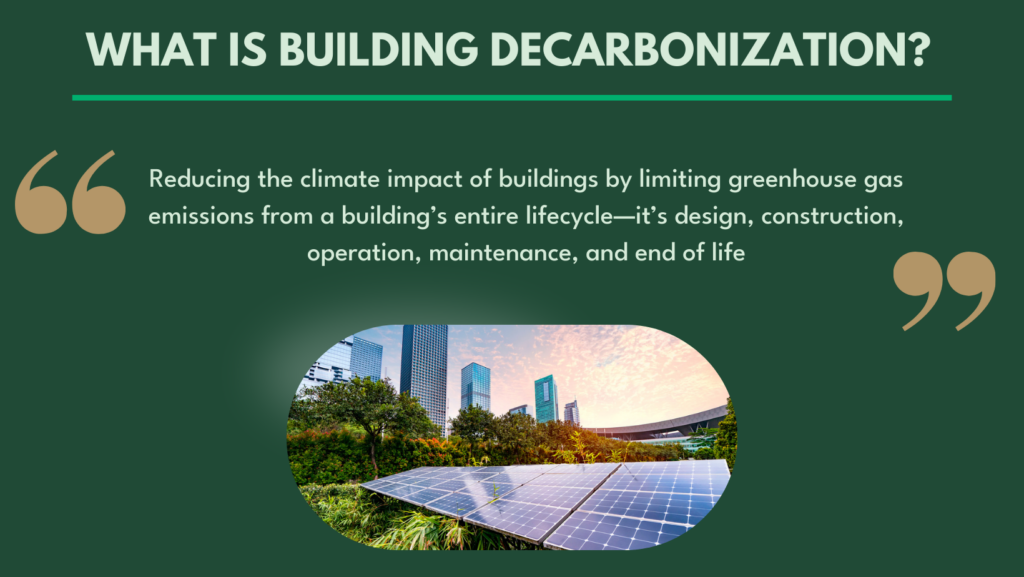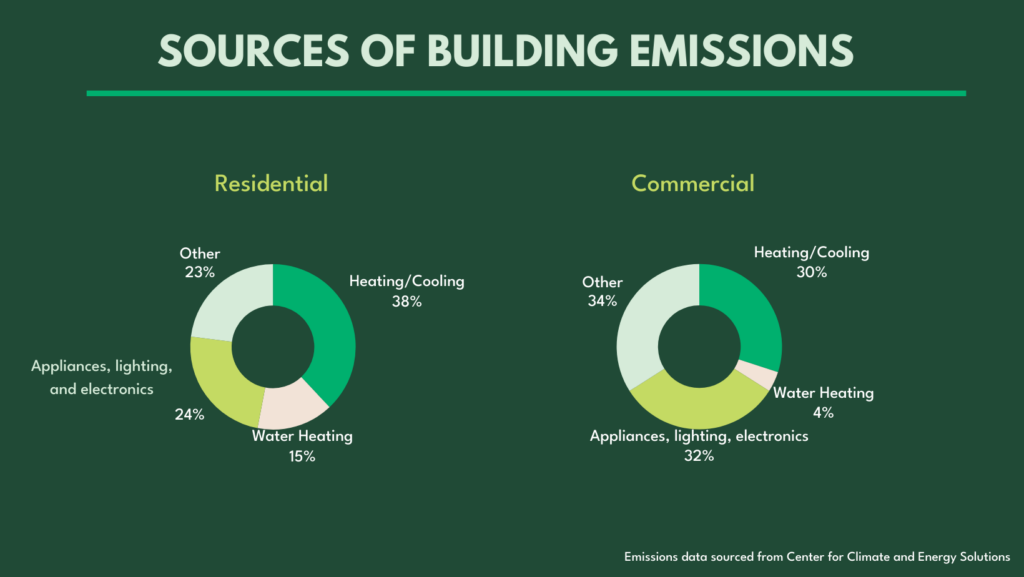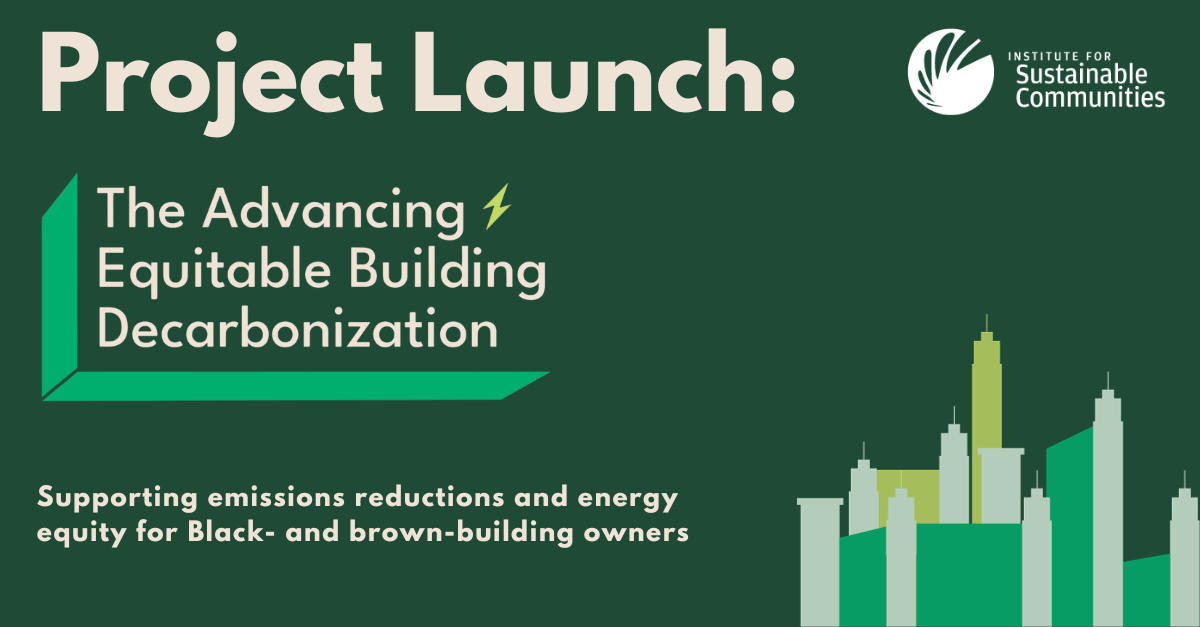Building decarbonization is the reduction of greenhouse gas emissions from the buildings and houses and involves the entire lifecycle of buildings. Because buildings account for about 40% of carbon emissions globally, the decarbonization of buildings is very important in addressing climate change.
Reducing the climate impact for both new and existing buildings is especially critical as the number of buildings globally is expected to increase due to population and economic growth. But where do these emissions come from, how can the industry decarbonize, and what challenges are involved with decarbonization?

Why does building decarbonization matter?
The places that people live, play, and work in are an important part of life and impact everything from health, safety, and the ability to meet basic human needs. Buildings also contribute to increasing temperatures by producing their own greenhouse gas emissions through the way they’re built and how they’re operated.
Buildings that keep people cool during summer heat waves and protect from severe weather are more important now than ever for communities experiencing the effects of climate change. As climate change worsens, heat waves and the number of hot days a year continue to increase. This puts more people at risk for heat-related illnesses and can lead to severe health consequences such as hospitalization or death.
These challenges impact Black and brown communities, low-income areas, and individuals with health concerns more than others. In order to address these challenges, we must adapt our buildings to deal with a future that is hotter and experiences more extreme weather while also ensuring they don’t further contribute to climate change.
Where do emissions in buildings come from?

Building decarbonization takes into account emissions from the entire lifecycle of a building, which includes the design, construction, operation and maintenance, and the end of life of that building.
Embodied Emissions
Before and after the building is operating, there are emissions from the creation, disposal, and transportation of raw materials, such as steel, concrete, and insulation. These emissions are known as “embodied” or “embedded” carbon because they occurred before the building was in use and are still a part of the building.
Operational Emissions
Operational emissions include energy, water use, and refrigerants while a building is operating. Emissions in this category can include:
- Electricity created from burning fossil fuels used for powering lighting, electronics, and appliances
- Energy used for heating and cooling
- Emissions in refrigerants used for cooling and equipment
- Emission byproducts created during production, such as methane
As the temperatures increase, the need for more refrigeration and cooling increases. This will only increase the amount of fossil fuels used and greenhouse gasses emitted—creating a vicious feedback cycle. By reducing emissions from buildings, their impact on climate change can be decreased.
How can we reduce building emissions?
The two main ways to reduce building emissions are through electrification—replacing oil and gas-based power sources with renewable equivalents—and finding ways to use less energy for the same tasks—energy efficiency. Using electricity instead of burning fossil fuels for cooking and heating means that eventually, those activities must also be fueled by renewable energy as the United States continues to transition away from fossil fuels for electricity. An example of a technology that would be needed while using electricity is heat pumps. If 100 million homes transitioned from using natural gas to electricity, it could reduce 40 million metric tons of carbon dioxide per year—the energy equivalent of taking almost 9 million cars off the road each year.
Improving energy efficiency in buildings can be enforced through updating efficiency standards in tandem with stronger local building codes that require energy-efficient technologies to be implemented in new and existing buildings. Examples of these technologies include installing LED lights, programmable thermostats, and wall insulation.
What future can we create by reducing building emissions?
Imagine the cascading impacts that any one of these single items could have on an individual, family, community, state, county, and our globe. The possibilities are endless and could lead to a more just future if implemented through strategies that center those who are least able to adapt to these changes. This future is worth tackling any challenge that comes with reducing building emissions. Some of these challenges include:
- High cost to change new and existing buildings
- Large upfront costs prevent landlords from transitioning to more energy-efficient systems
- Without policies and incentives in place, the burden of implementing these changes lies with the renter or homeowner.
- The high cost of sustainable changes often leads to economic inequities, favoring those who can afford these changes while disproportionately impacting people of color
When these challenges are addressed, we can create a pathway for the following opportunities:
- A future with cheaper energy bills
- A future with fewer respiratory illnesses
- A future with better air quality
- A future with healthier people
- A future with less industrial pollution in our communities
- A future with safe and affordable buildings that don’t further contribute to climate change
ISC's approach to building decarbonization
ISC’s Advancing Equitable Building Decarbonization (AEBD) project focuses on growing community capacity to implement equitable building decarbonization in communities of color. This project convenes leadership alliances in Oakland,CA, St. Louis, MO and Philadelphia, PA to implement demonstration projects and develop replicable products for directing resources toward Black and brown building owners. Learn more about AEBD and project participants.

